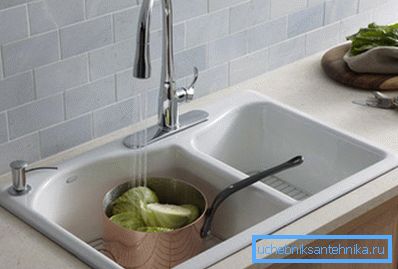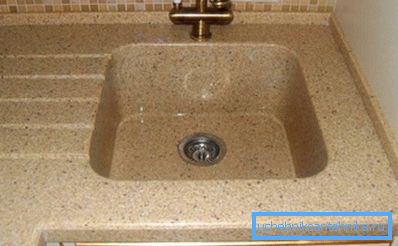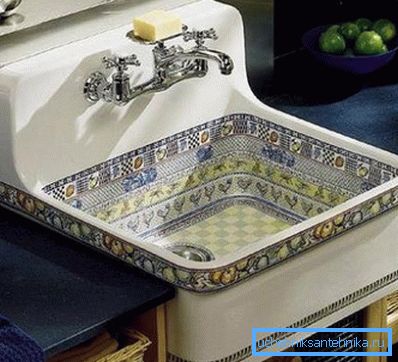Different sinks for the kitchen: get acquainted with the
If you are interested in what it is made of and how to install the kitchen sink with your own hands, then you will have to understand the materials of manufacture and methods of installation of these containers. The fact is that such shells are made not only from the usual stainless steel, but also from other natural and artificial materials.
Yes, and installation methods can also be very different from each other. We will discuss all these subtleties below, and in addition you can watch the thematic demonstration of the video in this article.

The main differences
By production material
Note. For some reason, it is considered that the capacity for the kitchen is called a sink, but for the bathroom it is called a sink. But this is not justified by anything, since a bowl of exactly the same shape from the same material can be mounted both in one and in another place. Just for the kitchen most often used steel options, and the name comes from washing dishes in it (although you wash your hands in the bathroom too).

- Stainless steel dishwashing cups are very popular, at least in Russia, and this is no accident - they are very convenient and reliable to use.. The steel sink is not afraid of sudden changes in temperature, does not break from the mechanical impact, it never cracks the coating and, moreover, they are the cheapest among the analogs. Even a used kitchen sink can serve you for many more years if it is easy to clean it with household cleaners.
- Stainless steel sinks can have a wide variety of shapes, however, like bowls of other materials, it is a square and a rectangle, a circle and an oval, as well as a triangle, if you need a sink in the corner of the kitchen. The thickness of the stainless sheet metal that is used for such containers varies from 0.4 to 1.2 mm, but the thicker the sink is, the safer it is, and the noise from the water jet in this case will be less, although the cost of the product increases proportionally. .

- First of all, it should be said that marble or granite shells can be made of natural stone, but their price is very high, and the installation of such structures is a rather laborious process, especially in the sense of cutting and drilling. Composite materials are much cheaper - they are not inferior in beauty and strength, their weight is much smaller, they are much cheaper and more accessible, and most importantly, they are much easier to process if the need arises.
- Thus, the composite consists of 80% granite or marble chips not exceeding the average fraction, and the remaining 20% of the total volume is occupied by polyester resins and dioxides (dyes). Such a mixture is poured into a mold and placed on a vibrating table, after hardening, it is released and left to solidify, and the final treatment is grinding on a special machine. These sinks are not afraid of shocks, scratches and temperature changes, so that they are very good for the kitchen.

- You can also find a sink made of ceramics on sale, but the materials here can be different - it is porcelain or earthenware, which is almost impossible to distinguish when looking at the surface of a container.. The fact is that earthenware has a more porous structure and in its pure form is unsuitable for products of this type, therefore, they are coated with glaze, which makes these two materials absolutely identical by visual definition.
- The problem of such sinks lies in the material itself and they have two main enemies - these are sharp temperature drops and sharp blows (the dishes fall into the sink), after which the surface begins to crack. Therefore, for the kitchen such capacity will be fully acceptable only if there is a dishwasher and the sink itself will be used for this only occasionally.
Note. Some users are searching the net to kill the fungus in the kitchen sink, but none of the materials contribute to its reproduction - this suggests that the sink is badly washed! In addition, if these formations occur in the sink, pay attention to whether there is a smell under the sink in the kitchen and if so, then you need to disassemble and clean the siphon well with detergents.
Mounting methods

The most common way to install the installation is when there is a ready-made stand for the kitchen sink, which can be a dresser or a cabinet with a carved worktop. The essence of the surface mounting is that the tank has sloping horizontal rims with which it lies on the base (cabinet or tabletop).
But this is not a general rule - there are sinks in the shape of a bowl, which are placed on the tabletop on a small hole for the siphon and the sides are not at all, but such containers are not used for the kitchen.

The most difficult is the embedded installation, where the sink is installed either flush with the tabletop, or slightly below its surface, as shown in the top photo. The main difficulty lies in the fact that such sinks are held not by their own configuration, but with the help of glue and / or various clips from below, so the installation process causes a lot of trouble and takes much more time.

But, as the invoice, and embedded installation may need to be inserted into the tabletop, which greatly complicates the situation, as it requires a lot of additional professional actions.
So, if the tie-in is done for the installation invoice, then it is a little easier and you will have to draw the desired contour using the washer turned upside down (then retreat from the line to the inside of the perimeter by the width of the rim) or a cardboard stencil from the manufacturer. For cutting usually use a jigsaw.

But if you need to cut under the embedded model, then the situation is complicated. Firstly, you will need a rigid template (usually it is included), secondly, you will cut with a router bit with an end cap, choosing grooves (radius attachment will be needed for removing the edge) and, thirdly, there will be several (depending on the configuration of the rim).
If the slice overlaps with the overlay installation, here it has a decorative character, therefore, such a process requires a certain skill.
Conclusion
When choosing an expensive kitchen sink should not rely on intuition when installing it, which will arise from a knowledgeable person at the sight of the configuration of the sink. The fact is that in the manual from the manufacturer there can always be an additional instruction that somehow corrects the whole process.